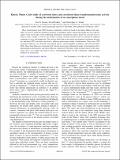Kinetic Monte Carlo study of activated states and correlated shear-transformation-zone activity during the deformation of an amorphous metal
Author(s)
Homer, Eric R.; Rodney, David; Schuh, Christopher A.
DownloadHomer-2010-Kinetic Monte Carlo study of activated states and correlated shear-transformation-zone activity during the deformation of an amorphous metal.pdf (863.7Kb)
PUBLISHER_POLICY
Publisher Policy
Article is made available in accordance with the publisher's policy and may be subject to US copyright law. Please refer to the publisher's site for terms of use.
Terms of use
Metadata
Show full item recordAbstract
Shear transformation zone (STZ) dynamics simulations, which are based on the kinetic Monte Carlo algorithm, are used to model the mechanical response of amorphous metals and provide insight into the collective aspects of the microscopic events underlying deformation. The present analysis details the activated states of STZs in such a model, as well as the statistics of their activation and how these are affected by imposed conditions of stress and temperature. The analysis sheds light on the spatial and temporal correlations between the individual STZ activations that lead to different macroscopic modes of deformation. Three basic STZ correlation behaviors are observed: uncorrelated activity, nearest-neighbor correlation, and self-reactivating STZs. These three behaviors correspond well with the macroscopic deformation modes of homogeneous flow, inhomogeneous deformation, and elastic behavior, respectively. The effect of pre-existing stresses in the simulation cell is also studied and found to have a homogenizing effect on STZ correlations, suppressing the tendency for localization.
Date issued
2010-02Department
Massachusetts Institute of Technology. Department of Materials Science and EngineeringJournal
Physical Review B
Publisher
American Physical Society
Citation
Homer, Eric R., David Rodney, and Christopher A. Schuh. “Kinetic Monte Carlo study of activated states and correlated shear-transformation-zone activity during the deformation of an amorphous metal.” Physical Review B 81.6 (2010): 064204. © 2010 The American Physical Society
Version: Final published version
ISSN
1098-0121
1550-235X